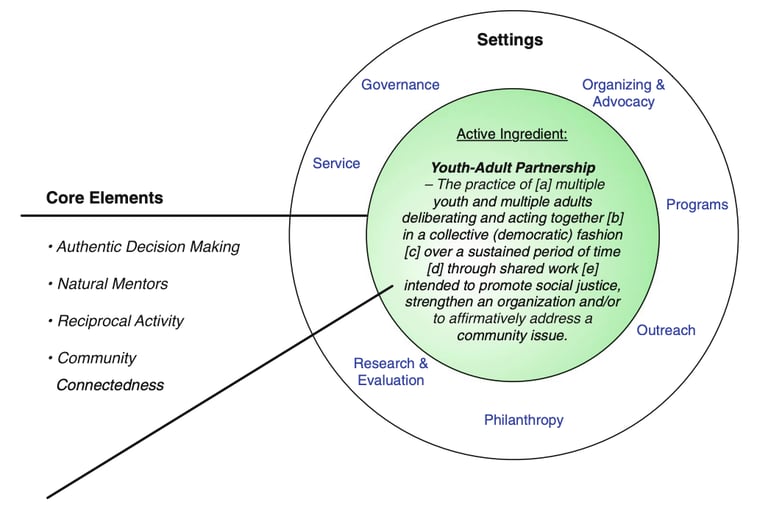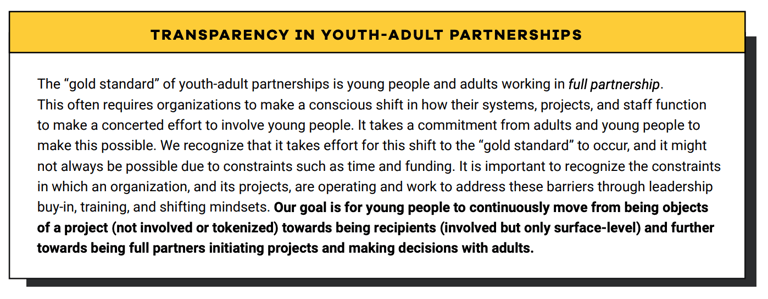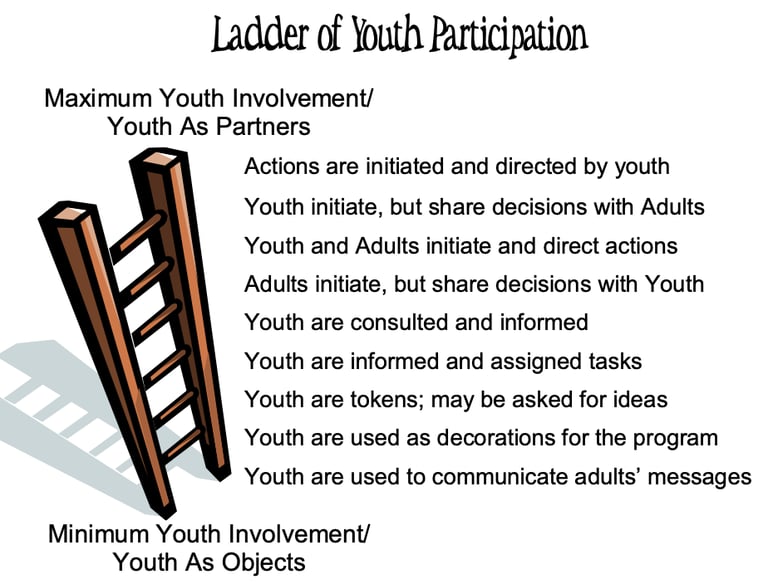Youth-adult partnerships in practice
An overview on youth-adult partnerships and how GFP USA is meaningfully incorporating them into our work.
STORY
Andrew Rahme
3/21/20249 min read
There are many ways youth-adult partnerships can be defined. For Generations For Peace USA’s (GFP USA) work with youth, the context is focused on empowerment, decision making, and consistent youth presence as they continue to develop as leaders. An empowering youth-adult partnership definition that can be applied to community-facing organizations like According to Shepherd Zeldin, Brian D. Christens, and Jane L. Powers in an article titled, "The Psychology and Practice of Youth-Adult Partnership: Bridging Generations for Youth Development and Community Change":
Youth-adult partnerships center youth as experts of their own reality, utilizing their experience and voice to help create programing, decide what relevant direction an organization should move towards, and offer insight in the effectiveness of organizational work, especially if the youth is also a participant in the organization. The following image from the above-mentioned article by Zeldin, Christens, and Powers lists the settings in which these partnerships can be formed and maintained:
“Youth-adult partnership is the practice of: (a) multiple youth and multiple adults deliberating and acting together, (b) in a collective [democratic] fashion (c) over a sustained period of time, (d) through shared work, (e) intended to promote social justice, strengthen an organization and/or affirmatively address a community issue.”


The concept of youth-adult partnerships has been gaining popularity, driven not only by its positive impact on youth but also by its potential to bring about genuine organizational change. This approach aims to train leaders in fostering inclusivity by actively involving youth in decision-making processes and encouraging creative brainstorming.
Although they were addressing states, the UN has also recognized the importance of youth agency, especially as it pertains to their direct experience. The following concept is an excerpt from Article 12 of the United Nations Convention on the Rights of the Child, and could/should be used in any organization serving youth:
“The views expressed by children may add relevant perspectives and experience and should be considered in decision-making, policymaking and preparation of laws and/or measures as well as their evaluation.”
What do positive youth-adult partnerships look like vs. negative ones?
Drawing from the National Network for Youth Youth-Adult Partnerships Toolkit, there are both negative and positive partnerships between youth and adults.
Positive Partnerships = Genuine power sharing with youth
Since there are several settings in an organization that these partnerships can thrive, it’s up to the organization to learn what setting is most accessible for youth, and where their skills and decision making can have weight. Using GFP USA as an example, it’d be effective to include youth voice in program creation, implementation, and evaluation. Participants can use the expertise of their lived experience to offer the organization insights while also learning leadership skills. Genuine partnerships can also include engaging youth in systems-level activities, such as advocacy, service coordination, allocation of resources, and program development.
Negative Partnerships = Tokenism
Although youth-adult partnerships have gained popularity, there are many partnership models that tokenize youth to bolster an organization’s presence in the community, for increased media engagement and funding opportunities. This is not always an organization’s intent, but if genuine partnership models aren’t centered on youth, the result will be disingenuous and harmful to both the organization and young leaders. To avoid tokenization, youth need a clear role to play in the organization and should not only be given entry level tasks that adult staff don’t want to do. It’s best to avoid using youth voice in media if said youth are not gaining anything from the partnership in the form of leadership opportunities. Youth are more than capable of leading, and many times bolster the success of an organization; they only need the trust and respect of adults to develop their leadership skills and have a positive impact on their community.


The above image was drawn from the Advocates for Youth Youth-Adult Partnerships Framework. Using the “gold standard” in youth-adult partnerships can help guarantee success for both the organization and youth leaders. The gold standard encourages us to make these partnerships possible by identifying what settings will offer the most leadership opportunities in a genuine way. Organizations must be realistic about their capacity to genuinely engage and include youth in leadership roles and should be considered the first step when thinking of forming these partnerships.
Potential Challenges
Retaining youth participants can be challenging when considering they typically have packed schedules because of school, sports, family obligations, and jobs. Retention should be a key focus when providing opportunities to partner with youth, and can be mitigated by keeping leadership roles engaging, meaningful, and most importantly accessible.
A willingness to include youth-adult partnerships also poses a challenge for many organizations because they are unfamiliar with this kind of power-sharing structure. Due to a lack of trust in the skillset of youth leaders, many adult professionals and organizations are weary of including youth in decision making processes and leadership roles due to lack of knowledge and understanding in the effectiveness of youth using their lived experiences and expertise to inform the direction of programs, leadership formation, and ways to address community needs. As adults in favor of youth leadership roles, it’s important to inform our organizations of the necessity of these partnerships and create a safe space for youth leaders to develop.
Lastly, youth-adult partnerships require a lot of focus, consistency, energy, and advocacy for youth leadership. This is the difference between tokenizing youth and genuinely engaging with them with respect. Their leadership must be centered in order for success to be sustained at the organization in a genuine way.
Recommendations: Creating the Conditions for Youth-Adult Partnerships
The 4-H Youth Adult Partnerships in Community Decision Making Guide serves as a blueprint for positive youth-adult partnerships and lists several recommendations to ensure success. It is based on four years of research from several practitioners from the University of Wisconsin Madison and the University of California-Davis, and lists detailed instructions on how to sustain and successfully maintain/promote these power sharing relationships. Building upon their recommendations, we suggest any organizations considering integrating youth-adult partnerships in their work:
Recommendation 1: Trust the Process
Youth-adult partnerships are a new concept for a lot of organizations. It’s important that staff must have confidence in ambiguity and risk when forming these partnerships. Each partnership will look different as there isn’t a model that fits all. This constant work, and restructuring and learning are all a part of the process. It's important to trust the process and remain flexible and adaptable. Assessment and reflection before, during, and after introducing youth-adult partnership processes can give valuable insights to keep organizations on the right track.
Example: The Youth Leadership Institute, through its model "Youth-Adult Partnership Assessment," offers a tool for organizations to evaluate their existing structures and relationships. Although it’s based specifically in health care settings, this serves as a helpful assessment that helps maintain balance with youth-adult decision making, ensuring that both organizational frameworks and interpersonal dynamics foster meaningful youth participation.
Recommendation 2: Balance Structures and Relationships
It’s crucial that organizations adopt new policies and deliberative bodies to validate youth input and uplift their decision-making capabilities. This includes promoting youth leadership with partner organizations and in the community at large. This creates a natural shift that can potentially change the way neighborhoods, organization networks, and cities view youth voice.
Example: Generations For Peace has created the “Thiqa” program, a collaborative project that seeks to amplify youth civic engagement by hosting consistent dialogue between local youth and officials from two municipalities in Jordan. This gives youth participants the opportunity to be involved in decision-making processes, creates a space where officials can learn and engage with participant’s lived experience, and helps create actionable plans that promotes inclusive decision making.
Recommendation 3: Anticipate and Plan for Transitions
Recruiting youth leaders, building leadership capacities, and creating new structures for youth involvement are steps that need to stay in constant motion when building youth-adult partnerships. This includes reassessing and removing potential barriers for youth involvement, being mindful of changing social and local norms, and creating clear roles and responsibilities so recruiting, onboarding, and offboarding of new youth leaders is expected, welcomed, and sustained.
Example: The YMCA's Youth in Government program has a well-defined transition plan for youth leaders, teaching organizations how to conduct a smooth handover of responsibilities and promoting a sustainable model for continued youth engagement. The program highlights leadership development for high school students and provides them the opportunity to be immersed in all aspects of their local government. They can learn first-hand from legislators, attorneys, executive officials, lobbyists, press members, and more. They then take these skills and utilize these relationships and apply it back to programming at the YMCA, creating cohorts of youth leaders with growing expertise that can be applied back under genuine partnerships for decision-making processes.
Recommendation 4: Foster Inclusive Decision-Making Spaces
Creating spaces where youth feel heard and valued is fundamental to the success of youth-adult partnerships. Nonprofits should actively seek to establish inclusive decision-making processes, where diverse voices contribute to shaping strategies and initiatives. This can be achieved through mechanisms such as youth-led committees, feedback sessions, and collaborative workshops.
Example: Chicago Youth Centers have created Youth Advisory Boards (YAB) to inform all programs in the communities they serve. These YABs help identify and recruit the organization’s board members, discuss needed resources and challenges faced by youth, and provide guidance to the center director in each community center. This is a genuine exchange of power in which youth voice is amplified and youth hold genuine decision-making powers.
Recommendation 5: Embrace Research and Knowledge-Sharing to Amplify Youth Voice
In an age where information is easily accessible, leveraging the skills of youth to conduct research and obtain information about factors affecting their everyday lives becomes pivotal in amplifying youth voices. Nonprofits should explore innovative platforms and tools that facilitate communication, collaboration, and idea-sharing among youth and adults. This not only enhances the accessibility of participations but also aligns with the preferences and communication styles of the younger generation.
Example: A Youth Participatory Action Research (YPAR) model is an excellent example of how knowledge-sharing and research can intersect to empower youth. Organizations like the Youthprise, a YSO based in Minneapolis, was the first organization to launch YPAR programs in Minnesota to engage youth in critical research on issues affecting their communities. This approach not only contributes valuable insights but also cultivates a sense of agency and ownership among youth participants, while giving them the opportunity to lead their own research projects and inform local stakeholders and a broader network of organizations and nonprofits.
Recommendation 6: Cultivate Mentorship Programs
Establishing mentorship programs is a transformative strategy that nurtures youth leadership. Pairing emerging leaders with experienced adults provides a structured avenue for skill development, knowledge transfer, and emotional support. Nonprofits should invest in mentorship initiatives that go beyond traditional hierarchical models, fostering mutual learning and growth.
Example: Big Brothers Big Sisters exemplifies the power of mentorship in youth development. Offering youth the opportunity to learn and engage with adults, particularly adults with a similar background and shared professional interests, gives youth a chance to be uplifted by mentors who provide guidance, encouragement, and support, creating a positive impact on the lives of both mentors and mentees. This knowledge sharing and mentorship model has proven successful for feelings of youth empowerment in comparison to youth who have less opportunities to engage with mentors and role models.
Recommendation 7: Advocate for Youth Representation in Governance
True empowerment goes beyond involvement; it involves giving youth a seat at the decision-making table. Nonprofits should actively advocate for youth representation on governing boards and committees. This not only ensures diverse perspectives but also solidifies the commitment to valuing youth contributions in shaping the organization's direction.
Example: The United Nations Youth Envoy serves as a global example of integrating youth into governance structures. The Youth Envoy represents the Secretary-General on youth-related matters, actively engaging with young people worldwide to amplify their voices in international decision-making processes. Making decisions that affect youth's present and future without their involvement is not only harmful to them, but equally harmful to us, as adults. The United Nations Youth Envoy ensures that youth voice is not only centered but has a seat at the table in the global context.
As organizations engage and serve youth, it’s our duty to create genuine opportunities for youth empowerment, innovation, and inclusivity. GFP USA's commitment to nurturing young leaders is not just an organizational ethos but a beacon for nonprofits seeking to meaningfully engage youth in leadership and decision-making. By following the recommendations and drawing inspiration from these examples, organizations can help foster a future where youth not only have a seat at the table but actively contribute to shaping a more just and equitable society.
As we navigate the evolving landscape of community-facing organizations, it’s essential to embrace the potential of youth-adult partnerships to amplify the voices of youth. Together, we can cultivate a culture where collaboration actively includes youth voice and expertise. Equity in relation to youth empowerment is not just a talking point for organizations, but an expected practice for organizations to create meaningful change.
The image below is the "Ladder of Youth Participation" from the Texas Network of Youth Services' Making It Work A Guide to Successful Youth-Adult Partnerships. It helps gauge meaningful youth participation in an organization. The top of the ladder is where true engagement and power sharing with youth should be for a positive youth adult partnership, while the bottom of the ladder sheds light on relationships that do not genuinely give youth the opportunity to lead. Where does your organization fall on the ladder, and how can you climb it in partnership with youth to ensure shared success?
Conclusion: Creating the Conditions for Youth-Adult Partnerships


Contact Us


5016 Centennial Blvd, Suite 200
Nashville, TN 37209
info@gfpusa.ngo
+1 (240) 383-1810
